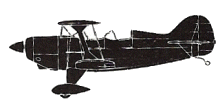
ASN Wikibase Occurrence # 65962
This information is added by users of ASN. Neither ASN nor the Flight Safety Foundation are responsible for the completeness or correctness of this information.
If you feel this information is incomplete or incorrect, you can submit corrected information.
| Date: | Thursday 25 June 2009 |
| Time: | 18:15 |
| Type: |  Pitts S-2B |
| Owner/operator: | Private |
| Registration: | N300FA |
| MSN: | 5055 |
| Total airframe hrs: | 1240 hours |
| Engine model: | Lycoming AEIO-540 |
| Fatalities: | Fatalities: 0 / Occupants: 1 |
| Aircraft damage: | Substantial |
| Category: | Accident |
| Location: | Quarter mile outside OBI. (Woodbine Muni. NJ) -
 United States of America United States of America
|
| Phase: | En route |
| Nature: | Private |
| Departure airport: | Bedford, MA (BED) |
| Wildwood, NJ (WWD) | |
| Investigating agency: | NTSB |
| Confidence Rating: |
Prior to departure, the pilot added a total of 20 gallons of fuel to the upper wing auxiliary and lower (main) tanks of the Pitts S-2B bi-plane, filling the tanks to their 28 gallon capacity. About halfway to the destination airport, after flying for about an hour, the pilot transferred fuel from the upper (auxiliary) to the lower (main) fuel tank. As the airplane approached the airport which the pilot planned to stop for fuel, the pilot determined a fuel stop was not necessary as his GPS predicted an arrival time at his destination equating to 2 hours of flight time. When the airplane was about 20 miles from its destination, the engine "quit abruptly" and the pilot performed a forced landing to a field. Examination of the airplane revealed the upper wing fuel tank contained approximately 3-5 gallons of fuel, and no fuel was observed in the main fuel tank. The fuel lines from the fuel servo contained only "residual fuel." The fuel selector was observed in the "ON" position. The fuel transfer valve, which transferred fuel from the upper wing fuel tank to the lower wing (main) fuel tank, was in the "CLOSED" position. The pilot believed the airplane's engine consumed about 11.5 gallons per hour; however, the manufacturer reported the airplane's engine consumed between 12 and 14 gallons per hour.
Probable Cause: A loss of engine power due to fuel starvation as a result of the pilot's improper fuel transfer in flight.
Accident investigation:
 |
|
Sources:
NTSB
Location
Images:

Photo: NTSB
Revision history:
| Date/time | Contributor | Updates |
|---|---|---|
| 25-Jun-2009 22:05 | Stonesurfer | Added |
| 25-Jun-2009 22:33 | slowkid | Updated |
| 27-Jun-2009 13:03 | Stonesurfer | Updated |
| 13-May-2010 05:39 | harro | Updated [Time, Source, Narrative] |
| 21-Dec-2016 19:25 | ASN Update Bot | Updated [Time, Damage, Category, Investigating agency] |
| 02-Dec-2017 15:38 | ASN Update Bot | Updated [Operator, Other fatalities, Departure airport, Destination airport, Source, Narrative] |
Corrections or additions? ... Edit this accident description
The Aviation Safety Network is an exclusive service provided by:


 ©2024 Flight Safety Foundation
©2024 Flight Safety Foundation